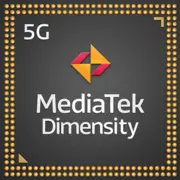MediaTek Dimensity 720

MediaTek Dimensity 720: A Balance of Performance and Affordability in 2025
Analysis of the chip for budget and mid-range smartphones
Introduction
In 2025, the mobile processor market continues to evolve, offering users increasingly advanced solutions. The MediaTek Dimensity 720, released back in 2020, remains popular in the budget segment due to its successful combination of price, energy efficiency, and 5G support. Let's explore what this chip is capable of today, who it is suitable for, and how it compares to its competitors.
1. Architecture and Process Technology: The Foundation of Efficiency
CPU: 8 Cores and 7 nm Technology
The Dimensity 720 is built on a hybrid architecture with two clusters of ARM Cortex cores:
- 2 Cortex-A76 cores with a frequency of up to 2.0 GHz for resource-intensive tasks: gaming, video rendering, AI applications.
- 6 Cortex-A55 cores with a frequency of up to 2.0 GHz for background processes, reducing power consumption.
The use of 7-nanometer process technology minimizes heat generation and increases efficiency. This is especially important for budget devices, where cooling systems are often simplified.
GPU: Mali-G57 MP3
The graphics processor with three compute cores (MP3) supports Vulkan and OpenGL ES 3.2 APIs, providing smooth operation in mobile games and applications with 3D graphics. However, for modern AAA games in 2025, its capabilities might not be sufficient—developer optimization will be crucial here.
2. Performance in Real Tasks
Gaming: Moderate Potential
- Genshin Impact: Medium settings (30 FPS) at 720p resolution.
- PUBG Mobile: Smooth gameplay on high settings (60 FPS in HD mode).
- Honkai: Star Rail: Low/medium settings due to demanding graphics.
For comfortable gaming, a cooling system is important. Devices with passive heat sinks or heat pipes show stability, while models without cooling may throttle.
Multimedia: 4K and HDR
- Supports 4K@30fps for video recording and content decoding.
- Hardware acceleration for HDR10+, enhancing image quality on AMOLED screens.
- Audio chip with Hi-Res Audio technology for detailed sound.
AI Applications: Basic Capabilities
The built-in neural processor (APU 3.0) accelerates:
- Photo processing (noise reduction, autofocus).
- Face and scene recognition in the camera.
- Background battery optimization.
For complex tasks, such as generating images via Stable Diffusion, the APU's power is insufficient—top-tier chips are required here.
Power Consumption and Heat Generation
A TDP of 10 W is a moderate figure. In smartphones with a 5000 mAh battery, battery life reaches 1.5-2 days under mixed usage. Heating rarely exceeds 42°C, which is comfortable for the hands.
3. Built-in Modules: Future Connectivity in the Past
5G Modem: Only Sub-6
- Supports 5G NSA/SA in Sub-6 GHz bands (speed up to 2.77 Gbps).
- The absence of mmWave makes the chip unsuitable for the US, but there are no coverage issues in Europe and Asia.
Wi-Fi and Bluetooth
- Wi-Fi 5 (802.11ac) with a maximum of 433 Mbps—sufficient for streaming, but slower than Wi-Fi 6.
- Bluetooth 5.1 with improved range and support for two devices simultaneously.
Navigation
- GPS, GLONASS, Galileo, BeiDou—quick satellite acquisition even in urban environments.
4. Comparison with Competitors
Snapdragon 4 Gen 2 (2023)
- Pros of Dimensity 720: Better multithreaded performance (1861 vs. 1650 in Geekbench 6 Multi-Core).
- Pros of Snapdragon: More recent GPU Adreno 619 (15% faster than Mali-G57 MP3 in games).
Exynos 1330 (2024)
- Pros of Exynos: Support for Wi-Fi 6 and Bluetooth 5.2.
- Pros of Dimensity: Energy efficiency (7 nm vs. 8 nm in Exynos).
Unisoc T820 (2025)
- Pros of Unisoc: Device prices starting from $180.
- Pros of Dimensity: Reliability and game optimization.
5. Use Scenarios
Gaming
Suitable for casual games (Candy Crush, Clash Royale) and moderately demanding titles (COD Mobile, Asphalt 9). For Genshin Impact or Wuthering Waves, settings will need to be lowered.
Everyday Tasks
- Smooth operation of social media, browsers, streaming services.
- Concurrent operation of 5-7 applications in the background.
Photo and Video
- Cameras up to 108 MP (with Quad-Pixel support).
- 4K video recording with EIS (Electronic Image Stabilization).
- Night Mode and Portrait modes with AI processing.
6. Pros and Cons
Strengths:
- 5G support at an affordable price.
- Energy efficiency (7 nm + Cortex-A55 optimization).
- Good multitasking performance.
Weaknesses:
- Outdated Wi-Fi 5.
- Mali-G57 MP3 struggles with top-tier games of 2025.
- Lack of mmWave 5G.
7. Practical Tips for Choosing a Smartphone
- Cooling: Look for models with graphite pads or liquid cooling (e.g., Realme 10 Pro).
- Display: An AMOLED screen with a 90 Hz refresh rate will enhance gaming and video experience.
- Battery: At least 5000 mAh for long battery life.
- Price: Devices with Dimensity 720 in 2025 cost $250–$400 (Xiaomi Redmi Note 13, Oppo A98).
8. Final Conclusion: Who is Dimensity 720 for?
This processor is a choice for those who:
1. Value price-to-quality balance—not overpaying for excess power.
2. Need 5G—for a future-oriented device.
3. Use their smartphone for basic tasks—social media, camera, undemanding games.
Key Benefits:
- Access to 5G without overpaying.
- Reliable battery life.
- Smooth operation in everyday scenarios.
If you're not a hardcore gamer and don’t plan to use your smartphone for 8K video editing, the Dimensity 720 remains a worthwhile option even in 2025.
Basic
6x 2 GHz – Cortex-A55
GPU Specifications
Connectivity
Memory Specifications
Miscellaneous
Benchmarks
Phones with Dimensity 720

Comparison of Devices with Dimensity 720
Compared to Other SoC
Share in social media
Or Link To Us
<a href="https://cputronic.com/en/soc/mediatek-dimensity-720" target="_blank">MediaTek Dimensity 720</a>